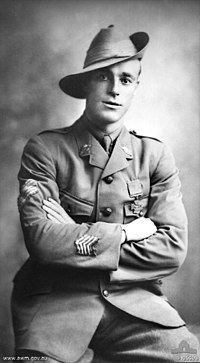Allegiance Australia Role Armed force officer Years of service 1914 – 1918 Service/branch Australian Army | Rank Sergeant Name Roy Inwood | |
 | ||
Battles/wars First World WarGallipoli CampaignWestern FrontBattle of Passchendaele Died October 23, 1971, St. Peters, Adelaide, Australia Similar People Phillip Davey, Douglas Haig - 1st Earl Haig, Erich Ludendorff, Hubert Gough, Friedrich Sixt von Armin | ||
Roy Inwood
Reginald Roy Inwood, VC (14 July 1890 – 23 October 1971) was an Australian recipient of the Victoria Cross, the highest award for gallantry in the face of the enemy that can be awarded to British and Commonwealth forces.
Contents
He was 27 years old, and a private in the 10th Battalion, Australian Imperial Force during the First World War when he performed an act of bravery for which he was awarded the Victoria Cross.
Early life
Born 14 July 1890 at North Adelaide, South Australia, the eldest son of Edward Henry Inwood and his wife Mary Anne (Minney). The family later moved to Broken Hill where, after leaving school, he began work in the local mines. Inwood enlisted in the 1st AIF, 10th Infantry Battalion on 24 August 1914 and on 20 October he embarked for Egypt where he took part in the Gallipoli Campaign landings. His battalion was in the first wave of the landing at Anzac Cove.
First World War
Inwood was awarded the Victoria Cross for actions during the period 19–22 September 1917 in an attack at Polygon Wood, near Ypres, Belgium during the Battle of Menin Road:
He later achieved the rank of sergeant. Inwood's two younger brothers also served and saw action on the Western Front. Pte Harold Ray Inwood, 43rd Battalion, returned to Australia in 1917; while Sergeant Robert Minney Inwood, also of the 10th Battalion, fought at Gallipoli and was killed in action on the second day of the Battle of Pozières on 24 July 1916 at the age of twenty.
Post-war life
Inwood returned to a hero's welcome in Broken Hill in October 1918 but at an event organised in his honour gave a controversial public speech. He claimed he had "been stoned by mongrels at the train" when he had departed to fight and with his return "those mongrels were the first to shake me by the hand". He told the crowd "I would like to be at one end of the street with a machine-gun and have them at the other end". In the House of Representatives Rep Michael Considine accused Inwood of trying "to incite trouble between returned soldiers and the working classes".
No longer welcome in Broken Hill Inwood moved to Adelaide where he found difficulty finding work. Inwood married a 23-year-old widow, Mabel Alice Collins Weber on 31 December 1918 but they divorced in 1921, whereupon he moved to Queenstown, Tasmania to work in the mines. He later moved to Kangaroo Island where he worked in a Eucalyptus distillery. Inwood married Evelyn Owens in 1927 and following her death married Louise Elizabeth Gates in 1942. Returning to Adelaide in 1928 he was employed as a labourer by the Adelaide City Council until 1955 when he retired. During the Second World War, Inwood served as a warrant officer with the Citizens Military Force.
Inwood died on 23 October 1971, given a military funeral he was buried at the West Terrace AIF Cemetery, Adelaide, South Australia.
Memorial controversies
In his will Roy Inwood bequeathed all his war medals to the 10th Battalion Club who, when informed, indicated they would donate the Victoria Cross itself to the Australian War Memorial. Inwood objected and stated he wanted the medal to remain in Adelaide. In June 1971, with Inwood's consent, the VC was presented to the City of Adelaide. The VC was stored in the high security vault in the Council’s Archives while a replica was put on display.
In 2005 Inwood's VC became the centre of considerable media and community debate with calls for it to be displayed in the Australian War Memorial's national Victoria Cross Collection. After consulting with the Inwood family and other interested parties, it was decided to honour Inwood’s dying wishes. In December 2005 funds were allocated to provide security so the original Victoria Cross could be displayed in the Adelaide Town Hall instead of the replica. In 2007 the debate briefly reignited and the matter remains a "touchy" subject.
The Other Ranks Mess at the Torrens Parade Ground, Adelaide, is called the Roy Inwood Club. In 2008 it was debated whether to call the new tunnel under Anzac Highway either "Inwood Underpass" or "Blackburn Underpass" after another South Australian who won a VC in 1916, Brigadier Arthur Blackburn. The Returned and Services League of Australia objected to naming the tunnel after a specific veteran as inappropriate saying it should be named after a major First World War battle ground in line with the highway's First World War memorial theme. On completion, the tunnel was named the Gallipoli Underpass.
